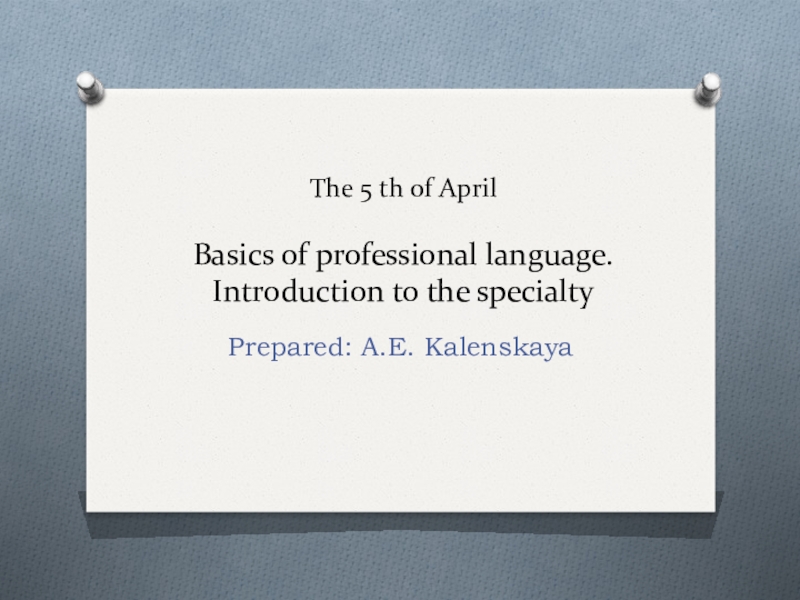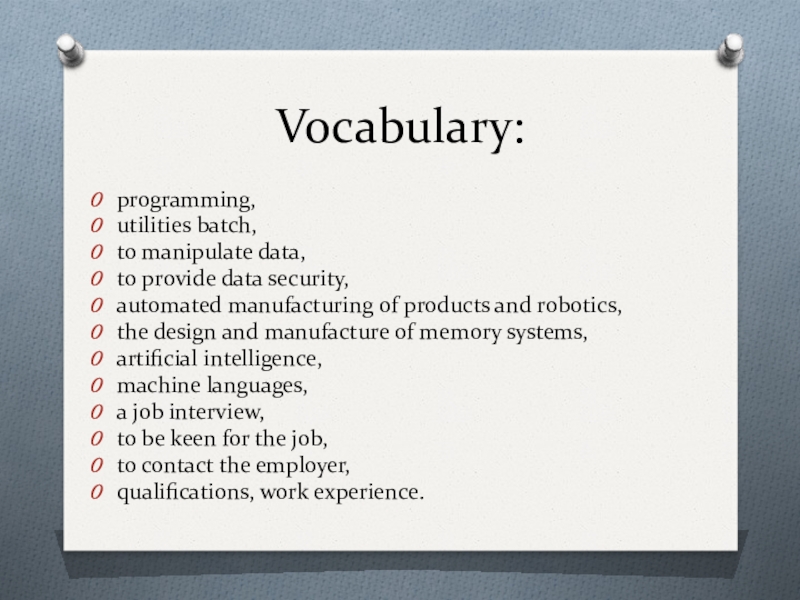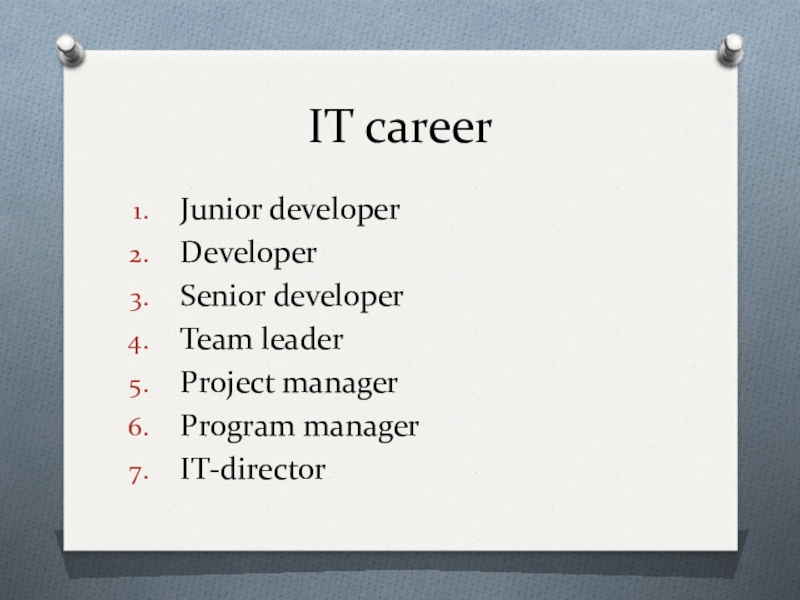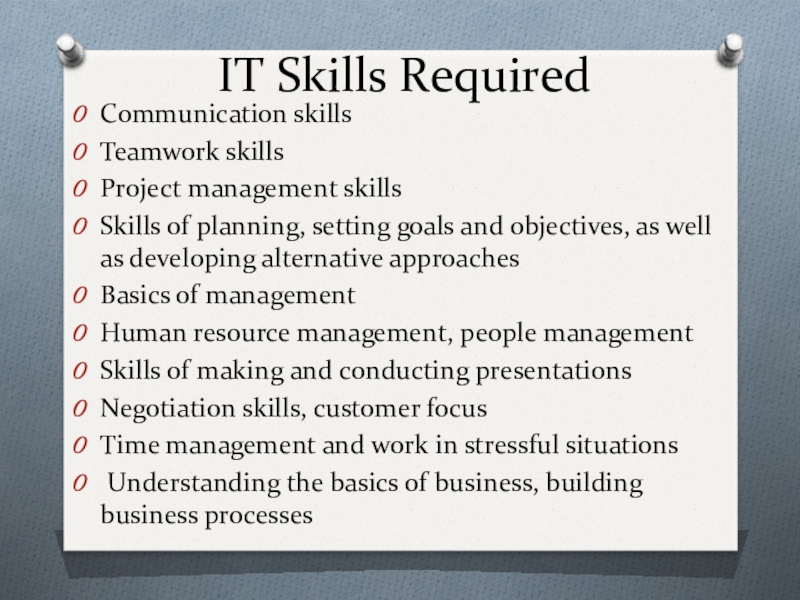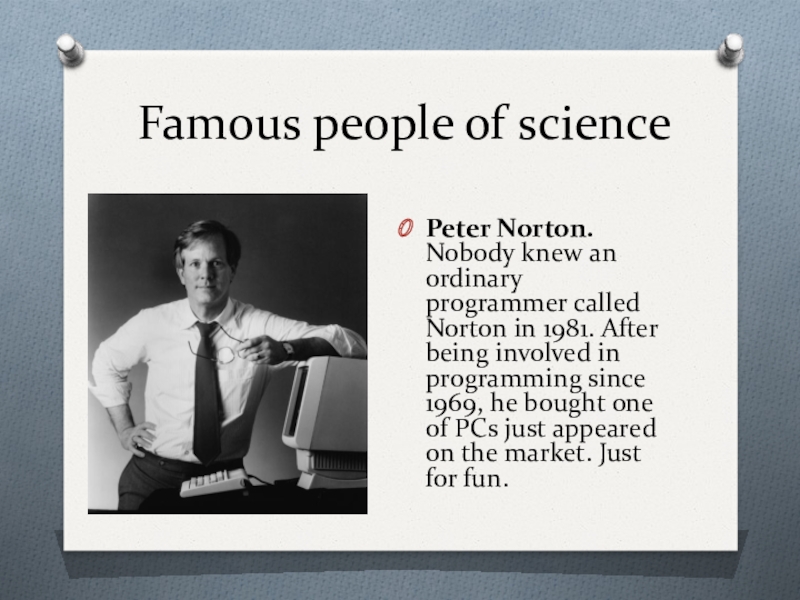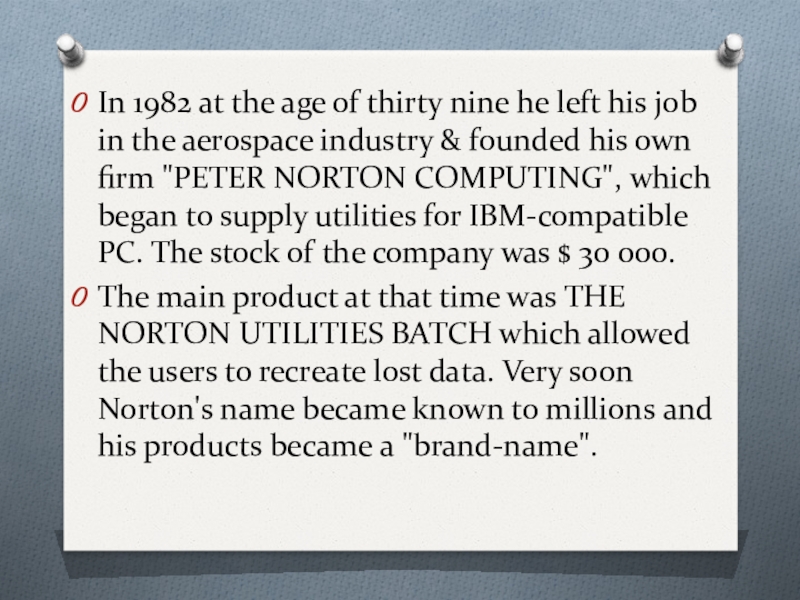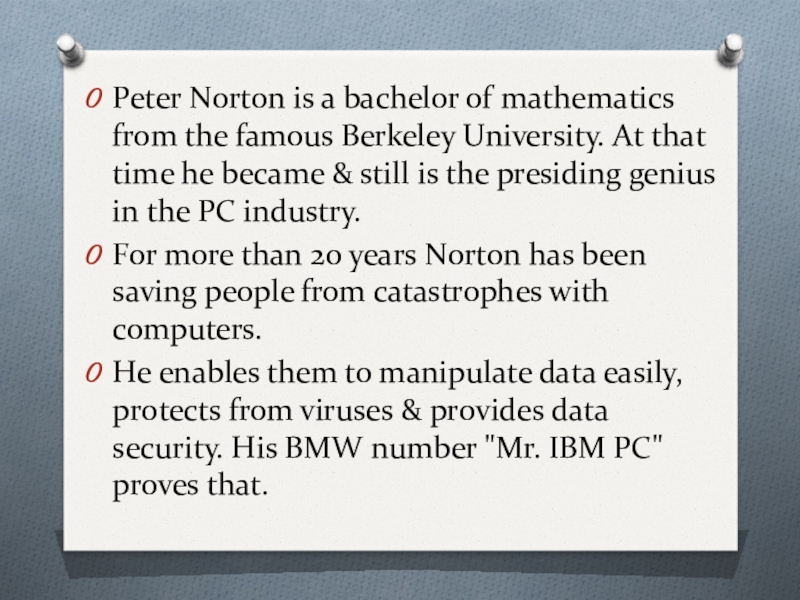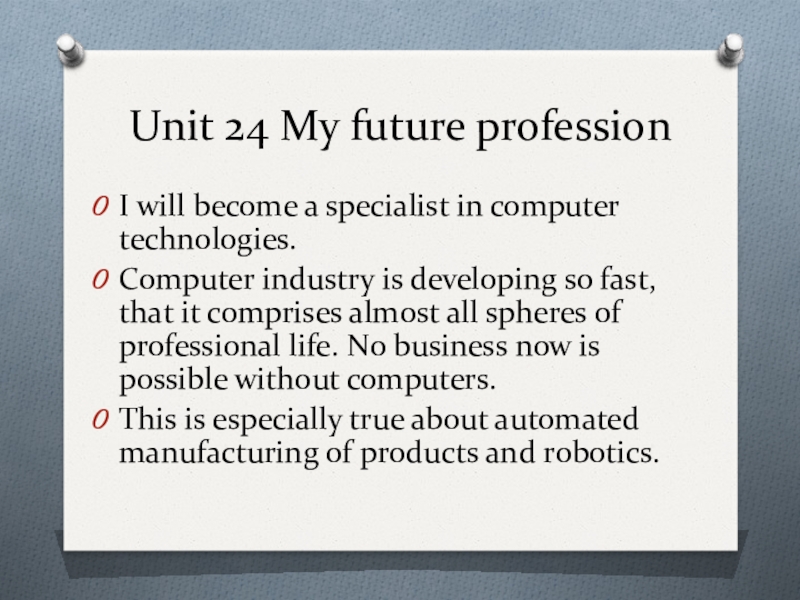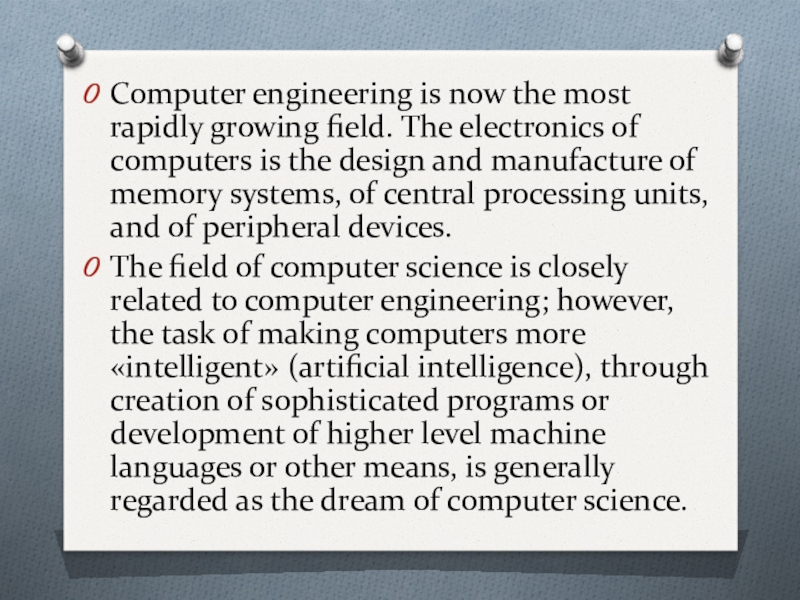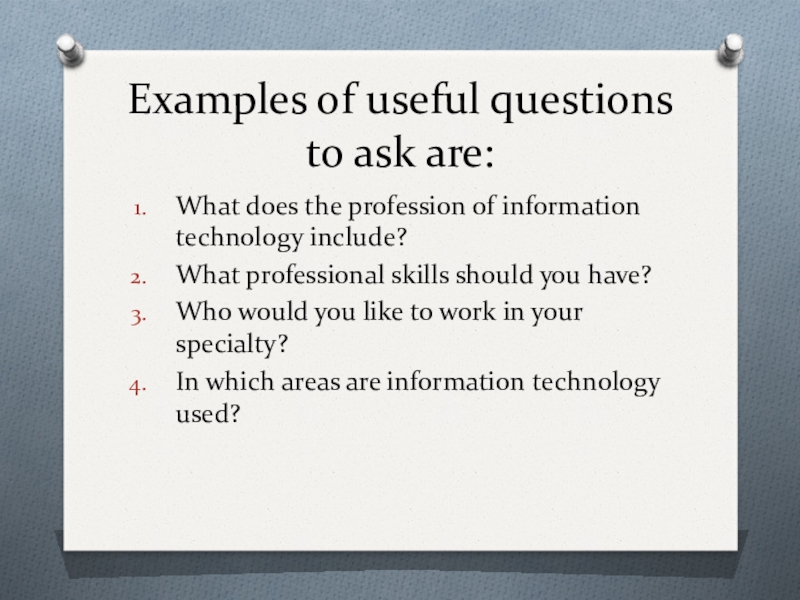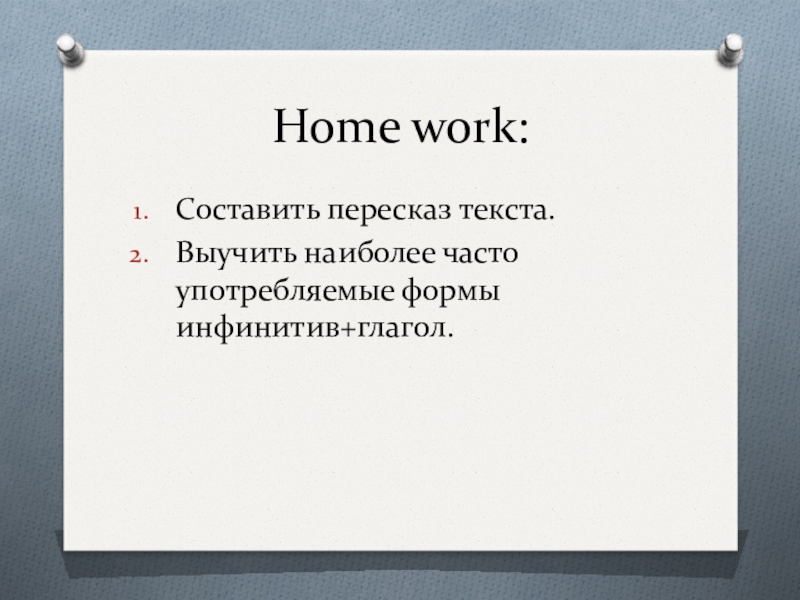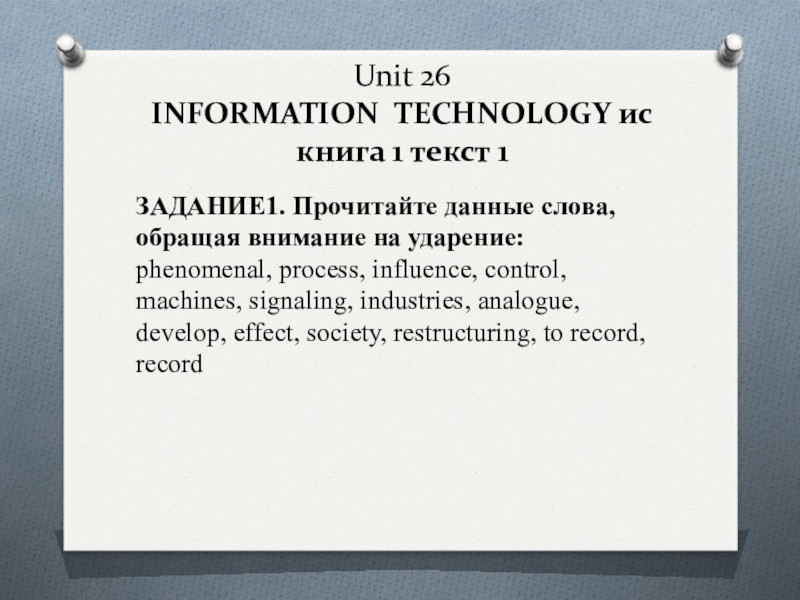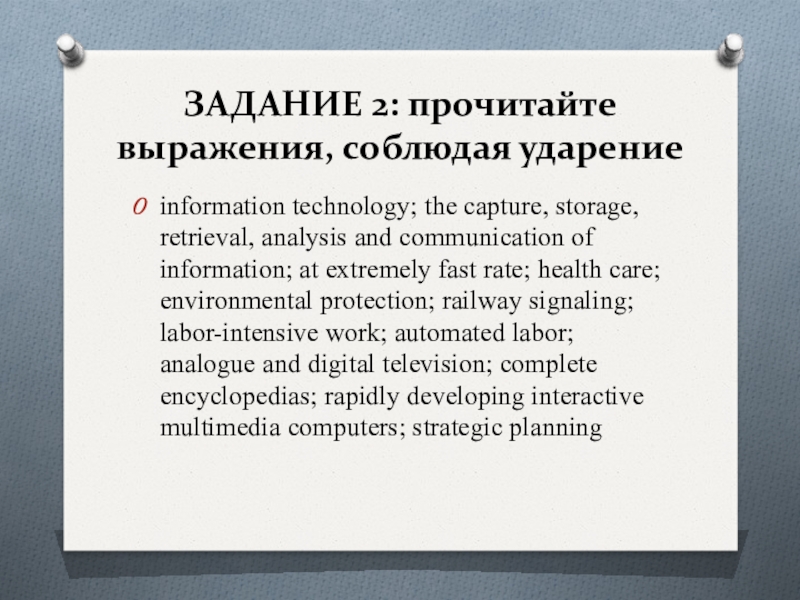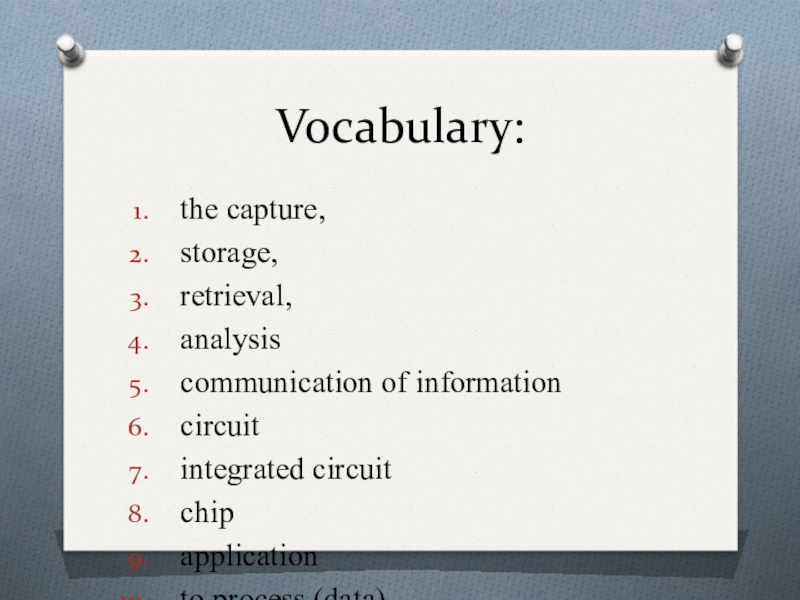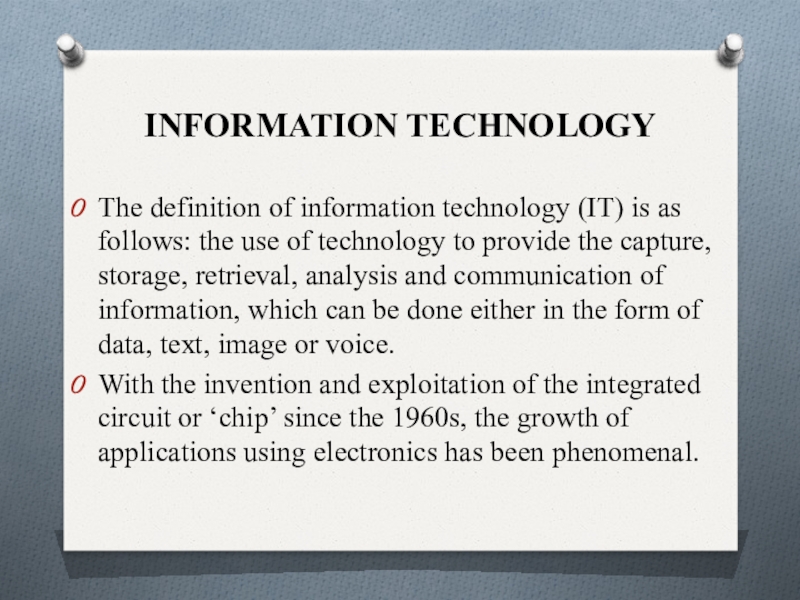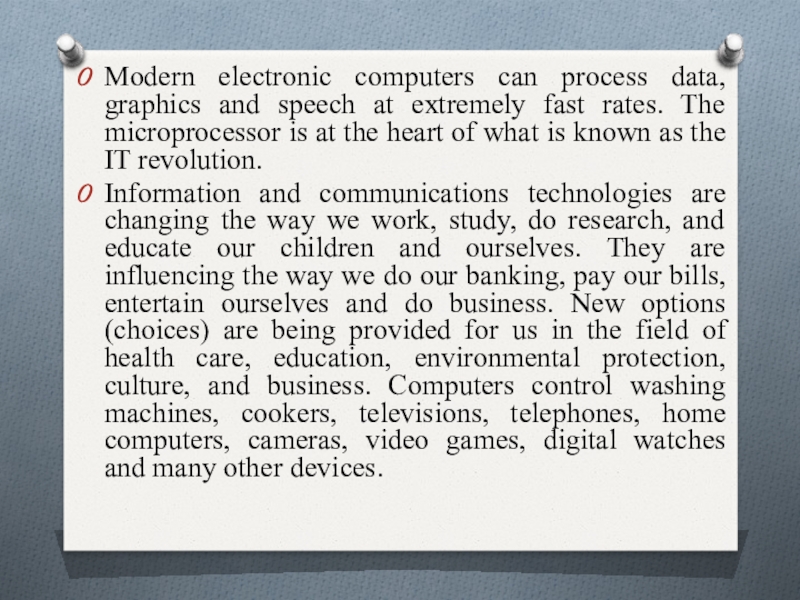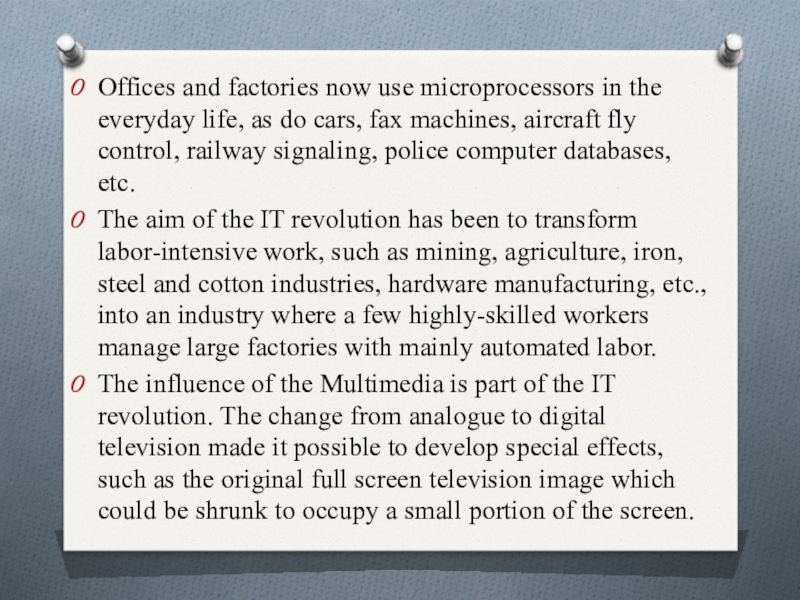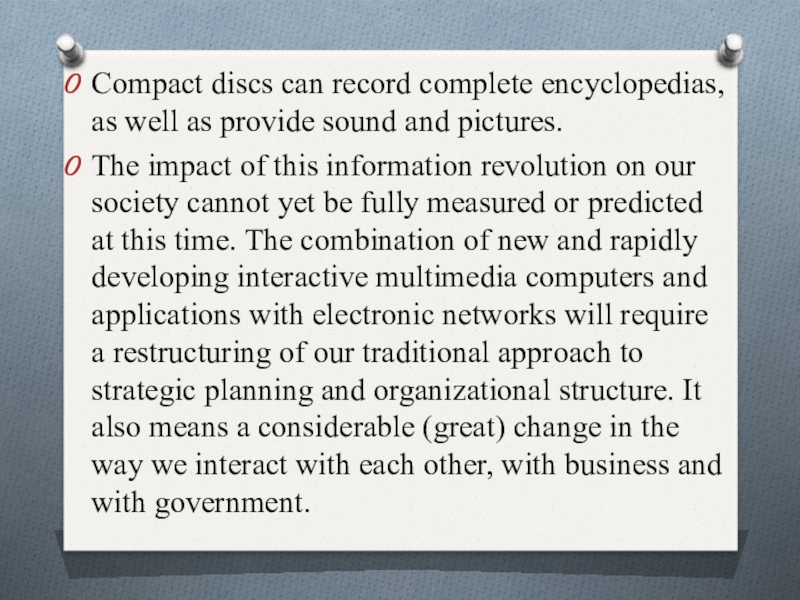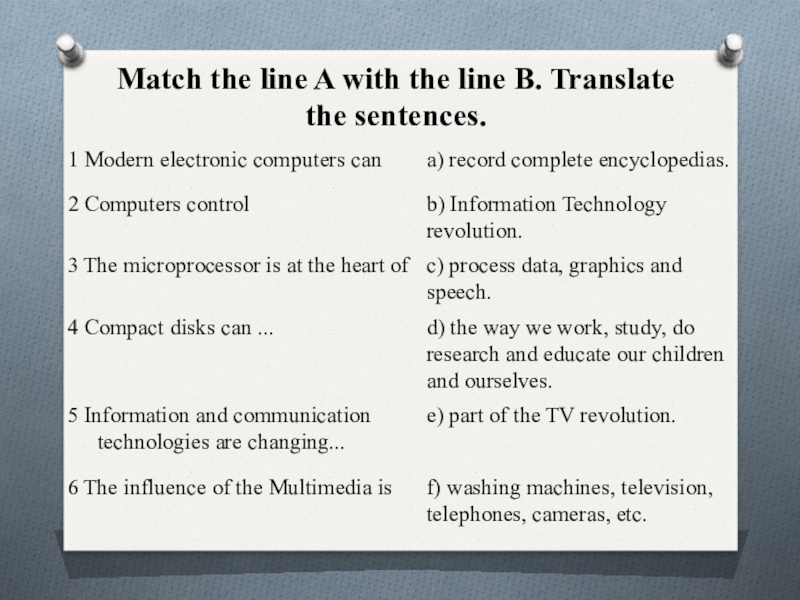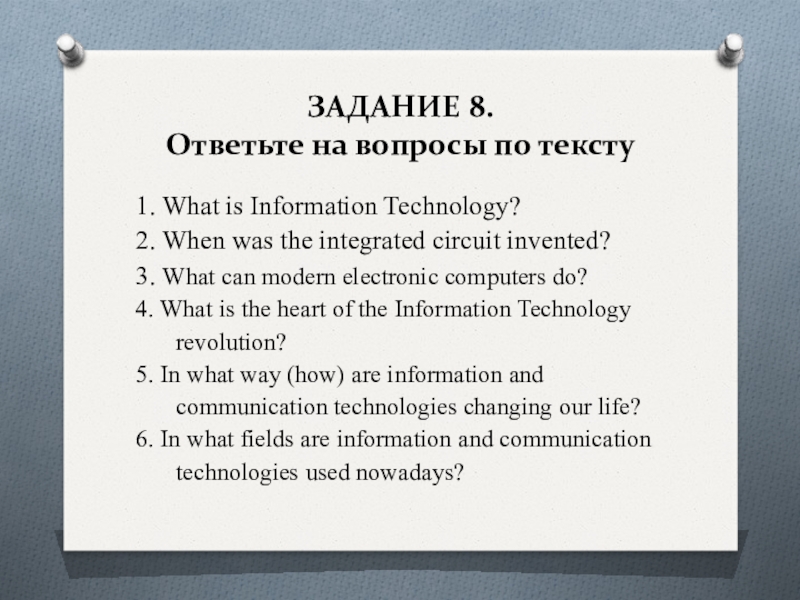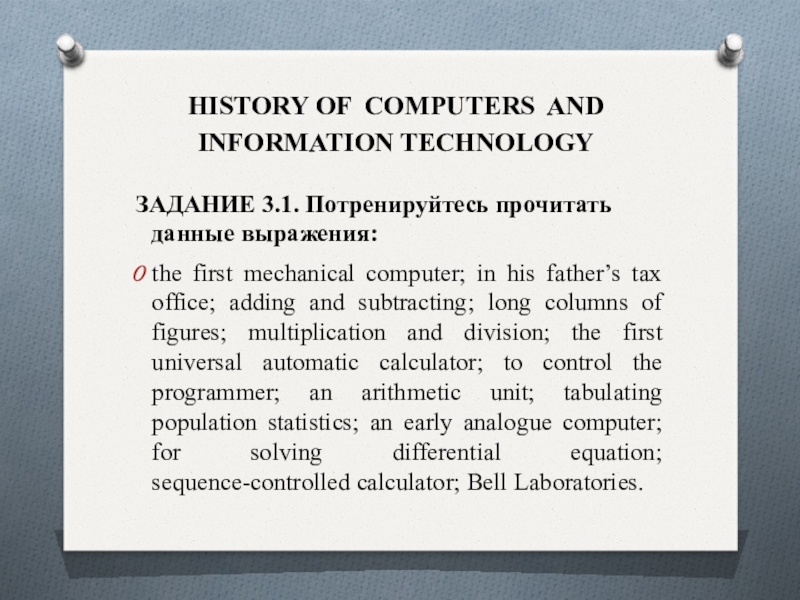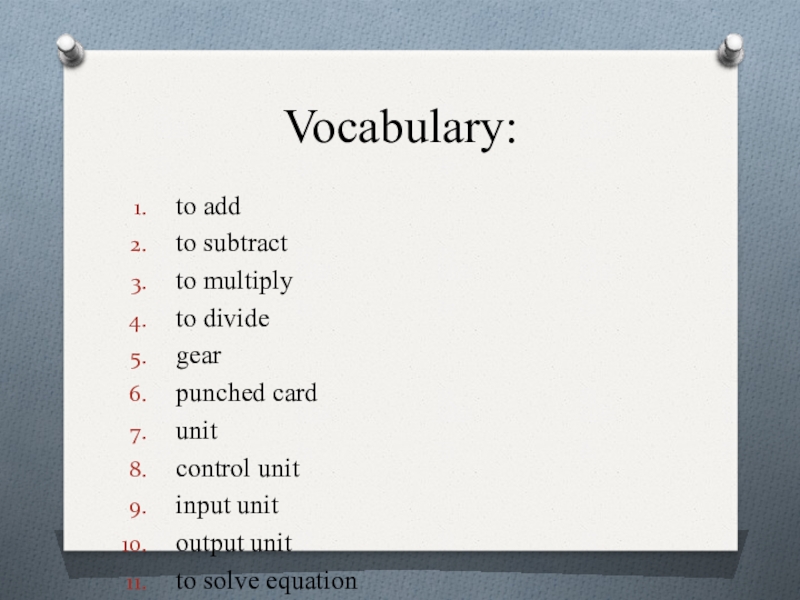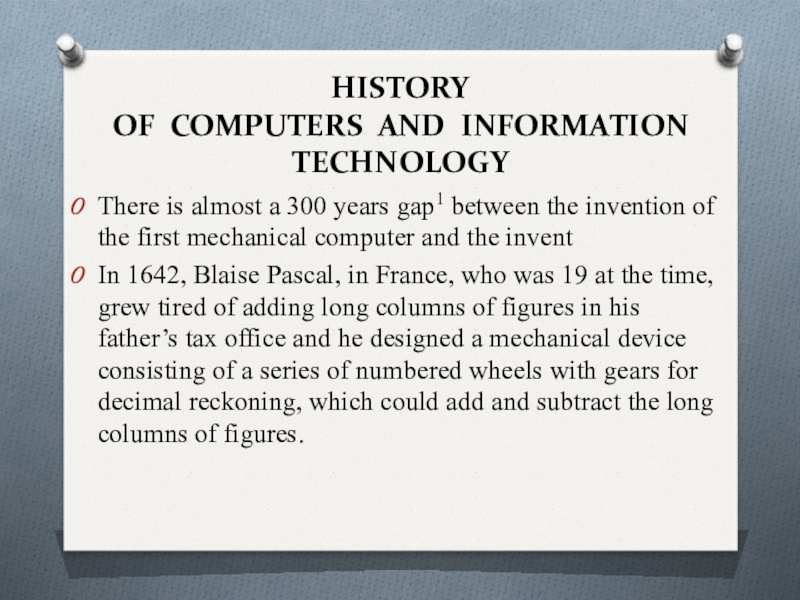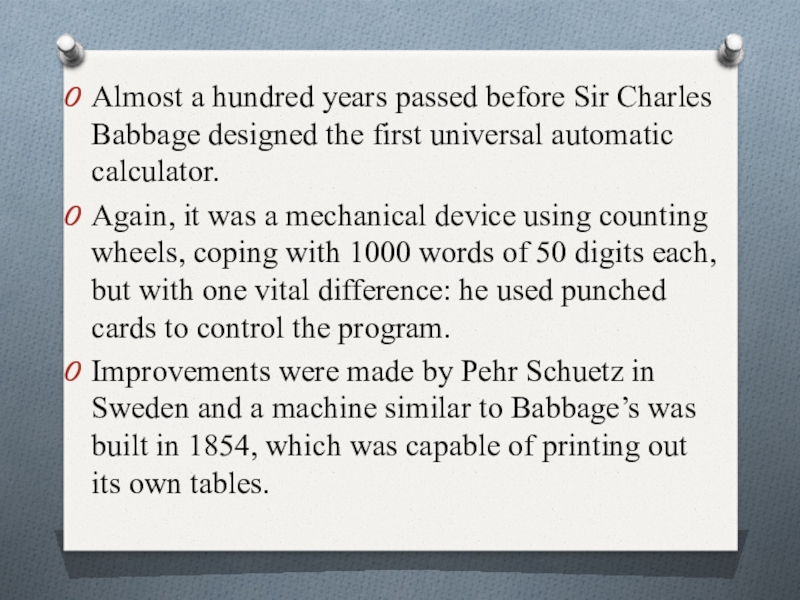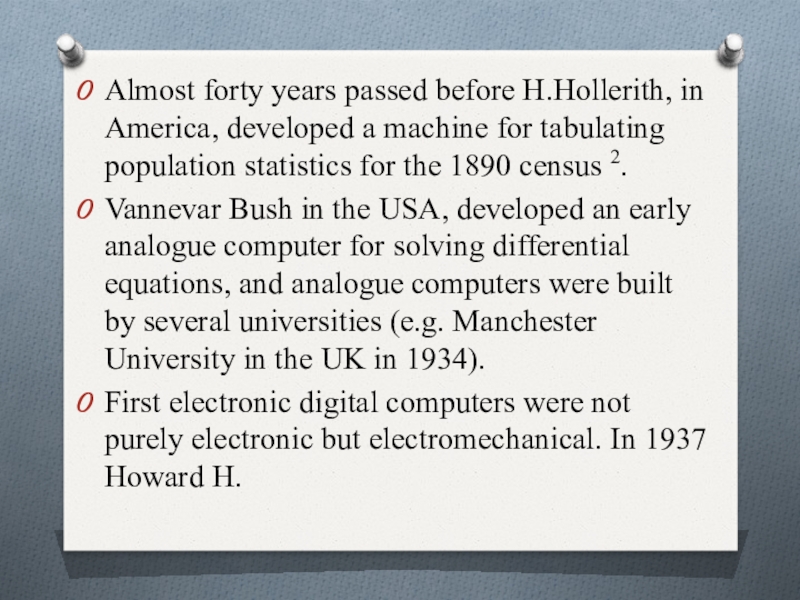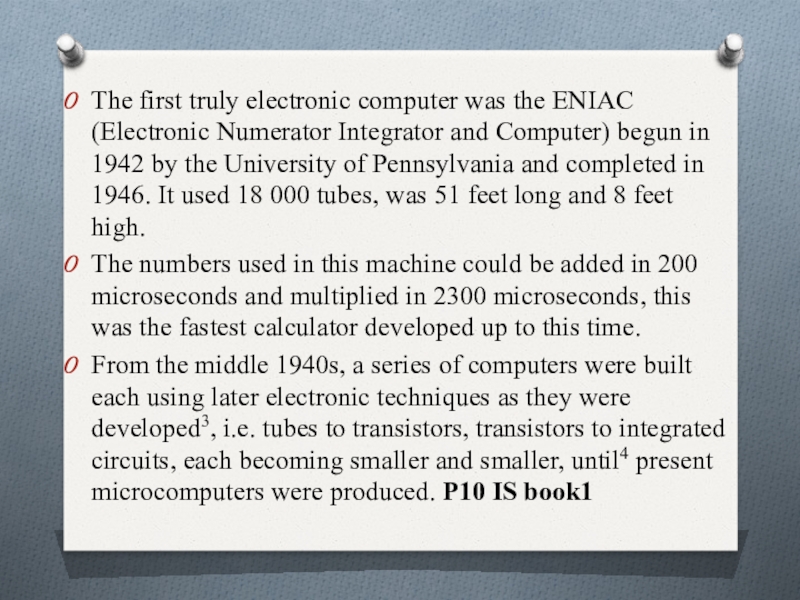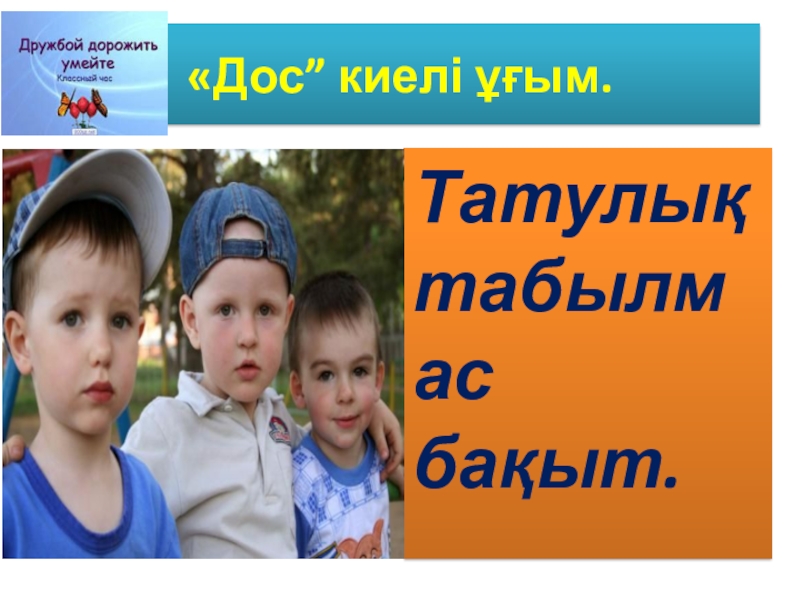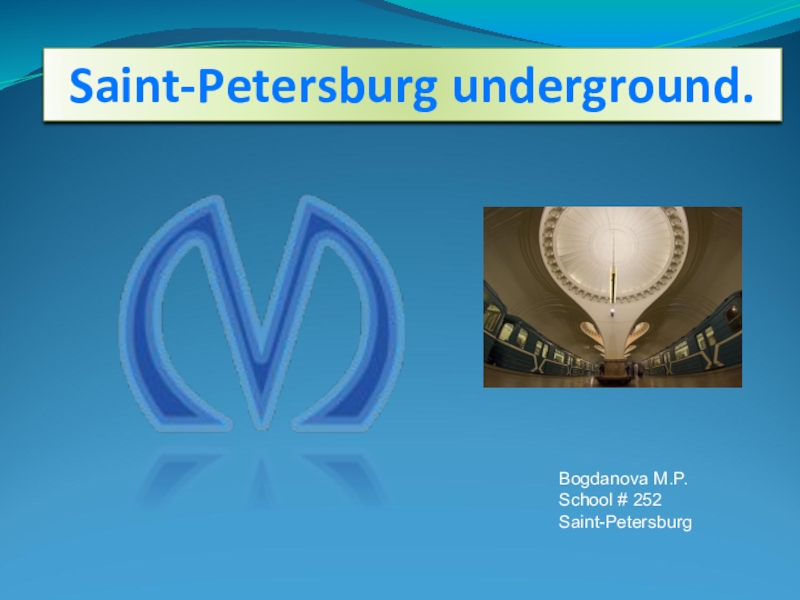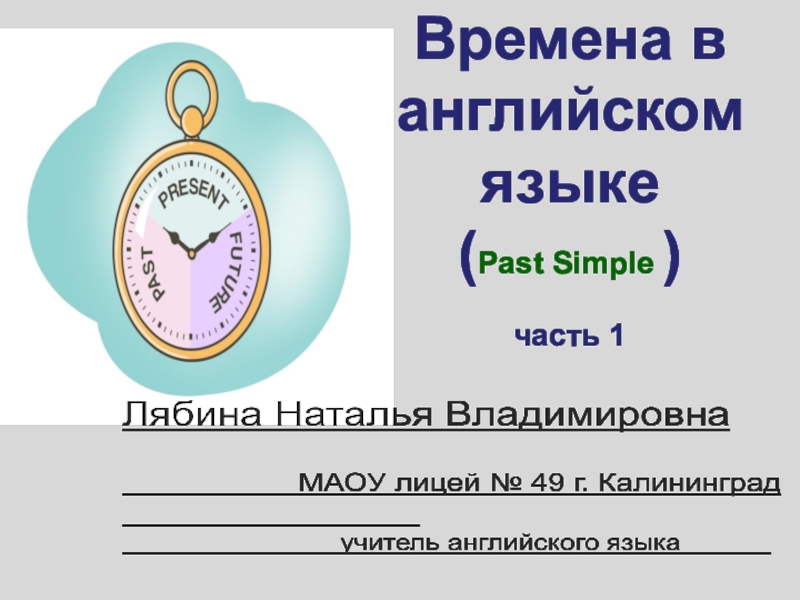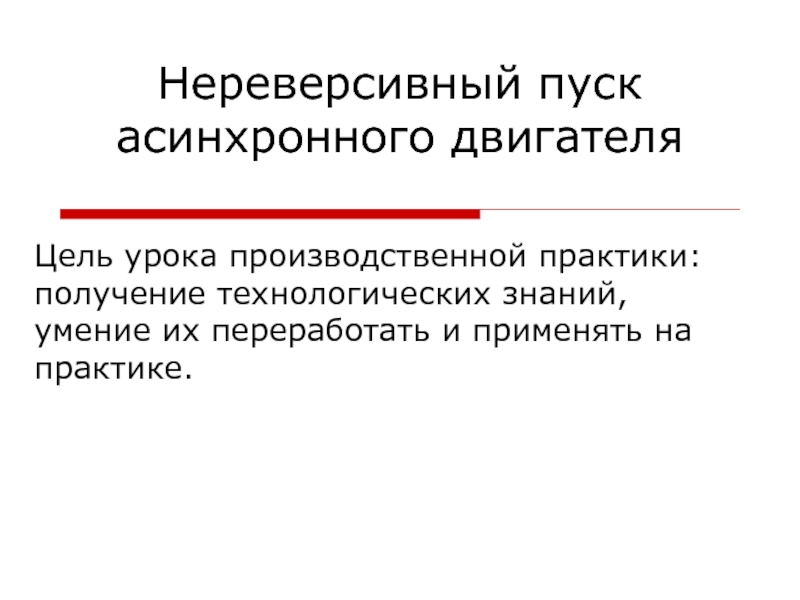Prepared: A.E. Kalenskaya
- Главная
- Разное
- Образование
- Спорт
- Естествознание
- Природоведение
- Религиоведение
- Французский язык
- Черчение
- Английский язык
- Астрономия
- Алгебра
- Биология
- География
- Геометрия
- Детские презентации
- Информатика
- История
- Литература
- Математика
- Музыка
- МХК
- Немецкий язык
- ОБЖ
- Обществознание
- Окружающий мир
- Педагогика
- Русский язык
- Технология
- Физика
- Философия
- Химия
- Шаблоны, фоны, картинки для презентаций
- Экология
- Экономика
Презентация, доклад на тему Basics of professional language. Introduction to the specialty
Содержание
- 1. Basics of professional language. Introduction to the specialty
- 2. The purpose of the lesson:Learn the basic
- 3. Vocabulary:programming, utilities batсh, to manipulate data, to
- 4. IT careerJunior developerDeveloperSenior developerTeam leaderProject managerProgram managerIT-director
- 5. IT Skills RequiredCommunication skillsTeamwork skillsProject management skillsSkills
- 6. Famous people of sciencePeter Nоrton. Nobody knew
- 7. In 1982 at the age of thirty
- 8. Peter Norton is a bachelor of mathematics
- 9. Unit 24 My future professionI will become
- 10. Computer engineering is now the most rapidly
- 11. Examples of useful questions to ask are:What
- 12. Home work:Составить пересказ текста.Выучить наиболее часто употребляемые формы инфинитив+глагол.
- 13. Unit 26 INFORMATION TECHNOLOGY ис книга 1
- 14. ЗАДАНИЕ 2: прочитайте выражения, соблюдая ударениеinformation technology;
- 15. Vocabulary:the capture, storage, retrieval, analysis communication of information circuit integrated circuitchipapplication to process (data)digitdigital
- 16. INFORMATION TECHNOLOGYThe definition of information technology (IT)
- 17. Modern electronic computers can process data, graphics
- 18. Offices and factories now use microprocessors in
- 19. Compact discs can record complete encyclopedias, as
- 20. Match the line A with the line B. Translate the sentences.
- 21. ЗАДАНИЕ 8. Ответьте на вопросы
- 22. HISTORY OF COMPUTERS AND INFORMATION TECHNOLOGYЗАДАНИЕ 3.1.
- 23. Vocabulary:to addto subtractto multiplyto dividegearpunched cardunitcontrol unitinput unitoutput unit to solve equation sequence-controlled calculatortube decimal
- 24. HISTORY OF COMPUTERS AND INFORMATION TECHNOLOGYThere is
- 25. Almost a hundred years passed before Sir
- 26. Almost forty years passed before H.Hollerith, in
- 27. The first truly electronic computer was the
The purpose of the lesson:Learn the basic terms associated with the specialty, summarize the previously studied material
Слайд 1The 5 th of April Basics of professional language. Introduction to the
specialty
Слайд 2The purpose of the lesson:
Learn the basic terms associated with the
specialty, summarize the previously studied material
Слайд 3Vocabulary:
programming,
utilities batсh,
to manipulate data,
to рrоvide data security,
automated
manufacturing of products and robotics,
the design and manufacture of memory systems,
artificial intelligence,
machine languages,
a job interview,
to be keen for the job,
to contact the employer,
qualifications, work experience.
the design and manufacture of memory systems,
artificial intelligence,
machine languages,
a job interview,
to be keen for the job,
to contact the employer,
qualifications, work experience.
Слайд 4IT career
Junior developer
Developer
Senior developer
Team leader
Project manager
Program manager
IT-director
Слайд 5IT Skills Required
Communication skills
Teamwork skills
Project management skills
Skills of planning, setting goals
and objectives, as well as developing alternative approaches
Basics of management
Human resource management, people management
Skills of making and conducting presentations
Negotiation skills, customer focus
Time management and work in stressful situations
Understanding the basics of business, building business processes
Basics of management
Human resource management, people management
Skills of making and conducting presentations
Negotiation skills, customer focus
Time management and work in stressful situations
Understanding the basics of business, building business processes
Слайд 6Famous people of science
Peter Nоrton. Nobody knew аn ordinary programmer called
Norton in 1981. After being involved in programming since 1969, he bought оnе of PCs just appeared оn the market. Just for fun.
Слайд 7In 1982 at the age of thirty nine he left his
job in the aerospace industry & founded his own firm "РЕТЕR NORTON COMPUTING", which began to supply utilities for IBM-compatible РC. The stock of the company was $ 30 000.
The main product at that time was ТНЕ NORTON UTILITIES BATCH which allowed the users to recreate lost data. Very soon Norton's nаmе became known to millions and his products became а "brand-name".
The main product at that time was ТНЕ NORTON UTILITIES BATCH which allowed the users to recreate lost data. Very soon Norton's nаmе became known to millions and his products became а "brand-name".
Слайд 8Peter Norton is a bachelor of mathematics from the famous Berkeley
University. At that time he became & still is the presiding genius in the РС industry.
For more than 20 years Norton has bееn saving people from catastrophes with computers.
Не enables them to manipulate data easily, protects from viruses & рrоvides data security. His BMW number "Mr. IBM РС" proves that.
For more than 20 years Norton has bееn saving people from catastrophes with computers.
Не enables them to manipulate data easily, protects from viruses & рrоvides data security. His BMW number "Mr. IBM РС" proves that.
Слайд 9Unit 24 My future profession
I will become a specialist in computer
technologies.
Computer industry is developing so fast, that it comprises almost all spheres of professional life. No business now is possible without computers.
This is especially true about automated manufacturing of products and robotics.
Computer industry is developing so fast, that it comprises almost all spheres of professional life. No business now is possible without computers.
This is especially true about automated manufacturing of products and robotics.
Слайд 10Computer engineering is now the most rapidly growing field. The electronics
of computers is the design and manufacture of memory systems, of central processing units, and of peripheral devices.
The field of computer science is closely related to computer engineering; however, the task of making computers more «intelligent» (artificial intelligence), through creation of sophisticated programs or development of higher level machine languages or other means, is generally regarded as the dream of computer science.
The field of computer science is closely related to computer engineering; however, the task of making computers more «intelligent» (artificial intelligence), through creation of sophisticated programs or development of higher level machine languages or other means, is generally regarded as the dream of computer science.
Слайд 11Examples of useful questions to ask are:
What does the profession of
information technology include?
What professional skills should you have?
Who would you like to work in your specialty?
In which areas are information technology used?
What professional skills should you have?
Who would you like to work in your specialty?
In which areas are information technology used?
Слайд 12Home work:
Составить пересказ текста.
Выучить наиболее часто употребляемые формы инфинитив+глагол.
Слайд 13Unit 26
INFORMATION TECHNOLOGY ис книга 1 текст 1
ЗАДАНИЕ1. Прочитайте данные слова,
обращая внимание на ударение:
phenomenal, process, influence, control,
machines, signaling, industries, analogue,
develop, effect, society, restructuring, to record, record
phenomenal, process, influence, control,
machines, signaling, industries, analogue,
develop, effect, society, restructuring, to record, record
Слайд 14ЗАДАНИЕ 2: прочитайте выражения, соблюдая ударение
information technology; the capture, storage, retrieval,
analysis and communication of information; at extremely fast rate; health care; environmental protection; railway signaling; labor-intensive work; automated labor; analogue and digital television; complete encyclopedias; rapidly developing interactive multimedia computers; strategic planning
Слайд 15Vocabulary:
the capture,
storage,
retrieval,
analysis
communication of information
circuit
integrated circuit
chip
application
to process (data)
digit
digital
Слайд 16INFORMATION TECHNOLOGY
The definition of information technology (IT) is as follows: the
use of technology to provide the capture, storage, retrieval, analysis and communication of information, which can be done either in the form of data, text, image or voice.
With the invention and exploitation of the integrated circuit or ‘chip’ since the 1960s, the growth of applications using electronics has been phenomenal.
With the invention and exploitation of the integrated circuit or ‘chip’ since the 1960s, the growth of applications using electronics has been phenomenal.
Слайд 17Modern electronic computers can process data, graphics and speech at extremely
fast rates. The microprocessor is at the heart of what is known as the IT revolution.
Information and communications technologies are changing the way we work, study, do research, and educate our children and ourselves. They are influencing the way we do our banking, pay our bills, entertain ourselves and do business. New options (choices) are being provided for us in the field of health care, education, environmental protection, culture, and business. Computers control washing machines, cookers, televisions, telephones, home computers, cameras, video games, digital watches and many other devices.
Information and communications technologies are changing the way we work, study, do research, and educate our children and ourselves. They are influencing the way we do our banking, pay our bills, entertain ourselves and do business. New options (choices) are being provided for us in the field of health care, education, environmental protection, culture, and business. Computers control washing machines, cookers, televisions, telephones, home computers, cameras, video games, digital watches and many other devices.
Слайд 18Offices and factories now use microprocessors in the everyday life, as
do cars, fax machines, aircraft fly control, railway signaling, police computer databases, etc.
The aim of the IT revolution has been to transform labor-intensive work, such as mining, agriculture, iron, steel and cotton industries, hardware manufacturing, etc., into an industry where a few highly-skilled workers manage large factories with mainly automated labor.
The influence of the Multimedia is part of the IT revolution. The change from analogue to digital television made it possible to develop special effects, such as the original full screen television image which could be shrunk to occupy a small portion of the screen.
The aim of the IT revolution has been to transform labor-intensive work, such as mining, agriculture, iron, steel and cotton industries, hardware manufacturing, etc., into an industry where a few highly-skilled workers manage large factories with mainly automated labor.
The influence of the Multimedia is part of the IT revolution. The change from analogue to digital television made it possible to develop special effects, such as the original full screen television image which could be shrunk to occupy a small portion of the screen.
Слайд 19Compact discs can record complete encyclopedias, as well as provide sound
and pictures.
The impact of this information revolution on our society cannot yet be fully measured or predicted at this time. The combination of new and rapidly developing interactive multimedia computers and applications with electronic networks will require a restructuring of our traditional approach to strategic planning and organizational structure. It also means a considerable (great) change in the way we interact with each other, with business and with government.
The impact of this information revolution on our society cannot yet be fully measured or predicted at this time. The combination of new and rapidly developing interactive multimedia computers and applications with electronic networks will require a restructuring of our traditional approach to strategic planning and organizational structure. It also means a considerable (great) change in the way we interact with each other, with business and with government.
Слайд 21
ЗАДАНИЕ 8.
Ответьте на вопросы по тексту
1. What is Information Technology?
2. When was the integrated circuit invented?
3. What can modern electronic computers do?
4. What is the heart of the Information Technology revolution?
5. In what way (how) are information and communication technologies changing our life?
6. In what fields are information and communication technologies used nowadays?
Слайд 22HISTORY OF COMPUTERS AND INFORMATION TECHNOLOGY
ЗАДАНИЕ 3.1. Потренируйтесь прочитать данные выражения:
the
first mechanical computer; in his father’s tax office; adding and subtracting; long columns of figures; multiplication and division; the first universal automatic calculator; to control the programmer; an arithmetic unit; tabulating population statistics; an early analogue computer; for solving differential equation; sequence-controlled calculator; Bell Laboratories.
Слайд 23Vocabulary:
to add
to subtract
to multiply
to divide
gear
punched card
unit
control unit
input unit
output unit
to solve
equation
sequence-controlled calculator
tube
decimal
sequence-controlled calculator
tube
decimal
Слайд 24HISTORY
OF COMPUTERS AND INFORMATION TECHNOLOGY
There is almost a 300 years gap1
between the invention of the first mechanical computer and the invent
In 1642, Blaise Pascal, in France, who was 19 at the time, grew tired of adding long columns of figures in his father’s tax office and he designed a mechanical device consisting of a series of numbered wheels with gears for decimal reckoning, which could add and subtract the long columns of figures.
In 1642, Blaise Pascal, in France, who was 19 at the time, grew tired of adding long columns of figures in his father’s tax office and he designed a mechanical device consisting of a series of numbered wheels with gears for decimal reckoning, which could add and subtract the long columns of figures.
Слайд 25Almost a hundred years passed before Sir Charles Babbage designed the
first universal automatic calculator.
Again, it was a mechanical device using counting wheels, coping with 1000 words of 50 digits each, but with one vital difference: he used punched cards to control the program.
Improvements were made by Pehr Schuetz in Sweden and a machine similar to Babbage’s was built in 1854, which was capable of printing out its own tables.
Again, it was a mechanical device using counting wheels, coping with 1000 words of 50 digits each, but with one vital difference: he used punched cards to control the program.
Improvements were made by Pehr Schuetz in Sweden and a machine similar to Babbage’s was built in 1854, which was capable of printing out its own tables.
Слайд 26Almost forty years passed before H.Hollerith, in America, developed a machine
for tabulating population statistics for the 1890 census 2.
Vannevar Bush in the USA, developed an early analogue computer for solving differential equations, and analogue computers were built by several universities (e.g. Manchester University in the UK in 1934).
First electronic digital computers were not purely electronic but electromechanical. In 1937 Howard H.
Vannevar Bush in the USA, developed an early analogue computer for solving differential equations, and analogue computers were built by several universities (e.g. Manchester University in the UK in 1934).
First electronic digital computers were not purely electronic but electromechanical. In 1937 Howard H.
Слайд 27The first truly electronic computer was the ENIAC (Electronic Numerator Integrator
and Computer) begun in 1942 by the University of Pennsylvania and completed in 1946. It used 18 000 tubes, was 51 feet long and 8 feet high.
The numbers used in this machine could be added in 200 microseconds and multiplied in 2300 microseconds, this was the fastest calculator developed up to this time.
From the middle 1940s, a series of computers were built each using later electronic techniques as they were developed3, i.e. tubes to transistors, transistors to integrated circuits, each becoming smaller and smaller, until4 present microcomputers were produced. P10 IS book1
The numbers used in this machine could be added in 200 microseconds and multiplied in 2300 microseconds, this was the fastest calculator developed up to this time.
From the middle 1940s, a series of computers were built each using later electronic techniques as they were developed3, i.e. tubes to transistors, transistors to integrated circuits, each becoming smaller and smaller, until4 present microcomputers were produced. P10 IS book1
